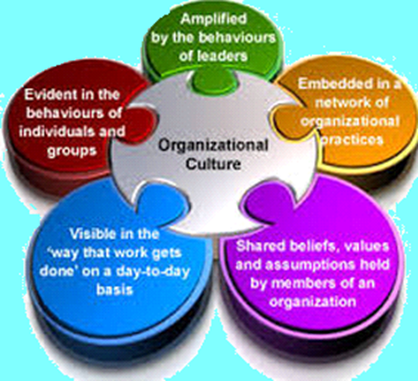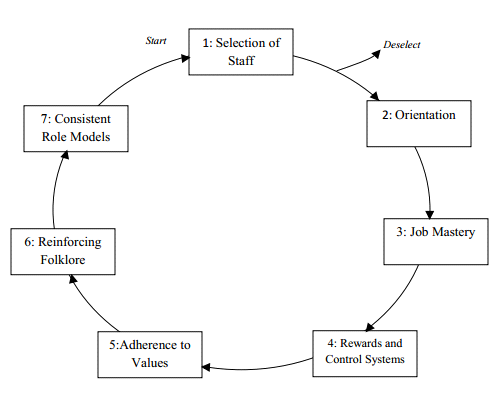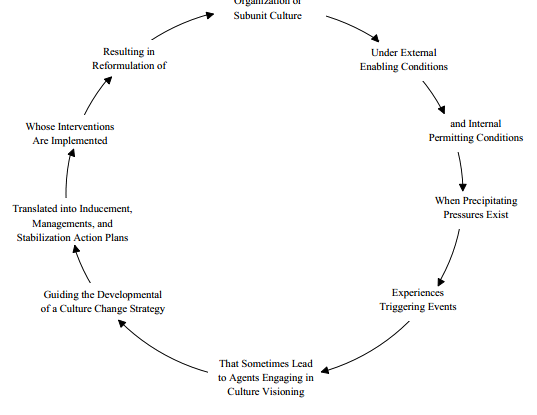Organizational theory and design - Organizational Culture (Organisational Behaviour and Design)
The concept of organization culture is thoroughly studied in organizational theory and design. Organizational culture attracted to organizational theorists and researchers who were dissatisfied with the usual formalistic, quantitative organizational research. Though, organizational culture was promoted in the beginning of 1980s, its roots can be traced back to the early human relations view of organizations that evolved in the decade of 1940s. Many researchers have designated that Culture is dynamic for success of an organization. It reduces vagueness by creating a common methodology and language for interpreting events and issues. It provides a sense of order so that all team members know what is expected; it creates a sense of continuity; it provides a common identity and unity of commitment, a sense of belonging; it offers a vision of the future around which a company can rely. It is, in short, an asset that can and should be managed in support of organization goals. Organizational culture is a shared beliefs, values, and norms that impact the thought process and behavior of the members. Culture is created through terminal and instrumental values and rituals, and communication networks. The prime methods to maintain organizational culture is through the socialization process by which individuals learn the values, expected behaviors, and social knowledge essential to assume their roles in the organization. Sometimes an organization determines that its culture needs to be changed.
Theoretical review: There are bulks of studies done to describe organizational culture. The notion of organizational culture was first explained as early as the Hawthorne studies (Mayo, 1933). Several social scientists define organizational culture as a perspective in organizational theory over the past decades. Brown (1998) states that "current interests in organizational culture stems from at least four different sources: Climate research, national cultures, human resource management and from conviction approaches which emphasize the rational and structural nature of the organization to be unable to offer a full explanation of organizational behavior". Edgar Schein stated that cultural analysis is particularly valuable to manage aspects of organizations that seem irrational, frustrating, and obstinate. Schein (1985) categorized three levels to describe organizational culture, namely artefacts, values and basic underlying assumptions. He noted that "The bottom line for leaders is that if they do not become conscious of the cultures in which they are embedded, those cultures will manage them". It is important that Schein uses the plural "cultures." Deal and Kennedy (1982) explored four generic types of cultures to label organizational culture, namely the tough-guy/macho culture, the work-hard/play-hard culture, the bet-your company culture and the process culture. O'Reilly, Chatman and Caldwell (1991) offered seven primary features to define organizational culture, namely innovation and risk-taking, attention to detail, outcome orientation, people orientation, team orientation aggressiveness and stability. According to Martins and Martins (2003, ), organizational culture is "a system of shared meaning held by members, distinguishing the organization from other organizations". Denison considered that organizational culture is entrenched in a set of basic assumptions, values and beliefs about employees, management, customers, shareholders, suppliers and others. Denison's model comprises of 4 basic dimensions and 12 sub-dimensions that are found to be related with organizational performance like return on investment return on assets, growth in revenues and sales, market share, innovation, quality of products and services, and employee satisfaction. The results were expressed in a model that measure four basic dimensions: Mission, Involvement, Adaptability, and Consistency.

The functionalist concept of culture developed the theoretical basis for comparative management research (Hofstede, 1991). Main presupposition of functionalist approach is that culture is a vital component of effective organizational performance. This view demonstrated that every organization possesses a culture, just as it has a strategy, technology, structure and employees. Organizational culture represents an objective reality of values, artifacts and meanings that can be quantified and measured. The culture, being an organization attribute, is 'given' to its members when they join, and they don't participate in its shaping. Social constructionist viewed that organizational culture is an organization and presents a subjective reality of rituals and meanings. It is viewed as social interaction result, as is a root metaphor for conceptualizing organizations (Smircich, 1983). As such, there is no place or time from which it can be finally captured and presented as the truth (Parker, 2000). Culture is a living and evolving reality (Morgan, 1997) and exists only as a pattern of symbolic relationships and meanings maintained through the continued processes of human interactions (Smircich, 1983). Zugaj and Cinguli (1992) stated that organizational culture is determined by a series of categories and ideas, the most common being are polite and civilized behavior of an individual (a civilized boy), Behavior of a social group (cultures of students, young liberals, punk movement, football fans), The time period of uniform style characteristics (the ancient culture, the renaissance culture, romanticism), The way of life and behavior of specific nations or groups of nations (the culture of the Incas, West European culture, Anglo-Saxon culture), Creativity of religious communities.
Organizational Culture can be of four types that include autocratic (or feudal), Bureaucratic, Technocratic, and Entrepreneurial (organic or democratic). Autocratic or feudal culture is pigeonholed by centralized power concentrated in a few persons, and observation of proper protocol in relation to the persons in power. Bureaucratic culture is defined by primacy of procedures and rules hierarchy, and distant and impersonal relationship. Technocratic culture highlights technical / professional standards and improvement. Entrepreneurial culture is concerned about attainment of results and providing excellent services to the customers.
Elements of Organizational Culture
Armstrong described that there are three important elements of organizational culture that include organization value, organization climate and manager style.
- Organization values represent everything what is considered to be valuable for the organization and what would have to and ought to happen. They are expressed as purpose, mission or strategic objectives of the organization.
- Organization climate is the company culture characterized by experience and understanding of the employees and/or by quality of organization value. This climate has impact on motivation, productivity, creativity and innovations.
- Manager style represents behavior of managers and the management of the organization when conducting their affairs. Literature abounds in descriptions of numerous management styles, which in most cases include either narrower or broader scope within two extreme styles: autocratic and democratic.
Megginson, Mosley and Pietri Jr. (1989) considered that the organizational culture has different elements. These are ceremonies, rituals, heroes, narrators, preachers, informers, gossipers, spies, myths and legends.
Though, there is substantial difference to define organizational culture, it has some peculiar characteristics:
Observed behavioral regularities: When organization members interact, they use common language, terminology, and rituals and ceremonies related to deference and manner.
Norms: Standards of behavior evolve in work groups that are considered acceptable or typical for a group of people. The impact of work-group behavior, sanctioned by group norms, results in standards and yardsticks for the organization.
Dominant values: An organization espouses and expects its members to share major values. Typical examples in schools are high performance levels of faculty and students, low absence and dropout rates of students, and high efficiency.
Philosophy: Policies guide an organization's beliefs about how employees and clients are to be treated. For example, most school districts have statements of philosophy or mission statements.
Rules: Guidelines exist for getting along in the organization, or the "ropes" that a newcomer must learn in order to become an accepted member.
Organizational Culture can have many functional that impact on the organizations and their management. The two major areas include adaptation to the Organization's external environment and Coordination of internal systems and processes. An organization that has successfully adapted to the external environment can build up culture with the agreement of the members about the organization's mission. The culture will include the specific goals derived from the mission and the means to arrive at these goals. If the consent about the mission is among the expert employees then the organization will move efficiently toward these goals as the members have the consent about what needs to be done and how it is to be done. It can be said that an organization's culture assists its members develop a sense of Identity with the organization and a clear vision of the organizations direction. In the well-established organizational culture, there is a feeling of belongingness amongst the members of the organization. They have clear and agreed views about the measurement of the results and take remedial action if there are some issues.
Deal and Kennedy (1984) recognized four dimensions of organizational culture these include values, heroes, rites and rituals, and communication networks. These four dimensions have an important role to develop organizational cultures. Values are general criteria, standards, or principles that direct the behavior of organization members (Jones, 2010). There are two types of values namely terminal and instrumental. A terminal value is defined as a desired outcome that organization members seek to achieve. Organizations adopt any of the following as terminal values: quality, excellence, and success (Bulach, Lunenburg, and Potter, 2012). An instrumental value is a desired mode of behavior. Modes of behavior include working hard, providing excellent teaching, respecting student diversity, being creative, teamwork, and maintaining high standards (Lunenburg and Ornstein, 2012). Therefore, an organization's culture comprises of outcomes that the organization seeks to accomplish and the modes of behavior the organization encourages.
Majority of successful organizations have their heroes. Heroes are born and created. Other characteristics of organizational culture are the daily activities and celebrations that characterize the organization. Most successful organizations feel that these rituals and symbolic actions should be managed. Through rites and rituals, organization gets recognition. Communication network is characterized by various individuals who play a role in the culture of the organization. Once an organizational culture is formed, various mechanisms assist to set the acceptance of the values and guarantee that the culture is maintained.
process of organizational socialization:

There are various components involved in the change cycle of organization (Frost, 1991):
- external enabling conditions,
- internal permitting conditions,
- precipitating pressures,
- triggering events,
- cultural visioning,
- cultural change strategy,
- culture change action plans,
- implementation of interventions, and
- reformulation of culture.
The change cycle of organizational culture.

To sum up, organizational Culture is a perceptive basis consisting of attitudes, values, behavioral norms and expectations shared by Organizational members. If organization has a strong culture, there are chances of improving its efficiency by increasing the competitive edge. Organizational culture encompasses the collective goals of a company and the standards of expected behavior to accomplish targeted goals. It describes the environment and manner in which employees interact with each other and market. Organizational Culture can strengthen strategic goals of the company by aligning the operations of the company, support skill development and operational performance by fostering an environment that values learning and progression.

